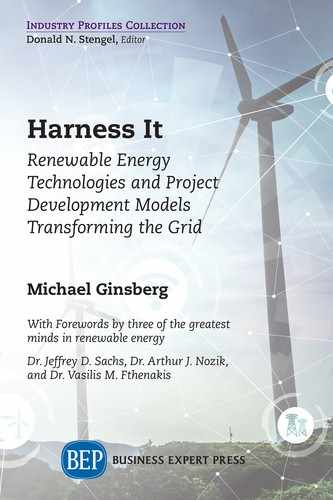At a time when energy systems must shift rapidly from fossil fuels to renewable energy, Michael Ginsberg has produced an enormously valuable guide to renewable energy for practitioners, students, and the broad public. Ginsberg explains the concepts of renewable energy and project development with great clarity and insight, and offers illuminating case studies to enable readers to get to the nitty-gritty regarding the design and economics of renewable energy projects. This book will be widely adopted as renewable energy investments are rapidly scaled up around the world.
The book arrives at a moment of decision for the world. Human-induced climate change is proceeding rapidly and dangerously. Around the world, climate-related disasters—heatwaves, floods, droughts, extreme storms, rising sea levels—are causing vast damages and loss of lives and livelihoods. In the 2015 Paris Climate Agreement, the world’s government determined to limit global warming to 1.5-degrees C relative to the pre-industrial average, yet average warming is already 1.1-degree C above the pre-industrial level and is rising by around 0.2-degree C per decade.
The most important step to achieving the 1.5-degree limit will be to decarbonize the world’s energy system by mid-century. This will entail a worldwide shift in primary energy from fossil fuels to zero-carbon primary energy sources, the most important of which will be wind, solar, hydroelectric, geothermal, and nuclear power. In turn, downstream users of energy, such as transport and buildings, will shift from direct combustion of fossil fuels to electrification, such as with battery electric vehicles. Yet the transition to variable renewable energy sources, mainly wind and solar power, presents novel challenges in planning, design, grid management, technology selection, project development, and financing. It is on these crucial and practical issues that Ginsberg focuses, and on which he delivers with clarity and insight.
As Ginsberg vividly describes, variable renewable energy raises countless challenges of energy intermittency, choices of integrating with the grid or opting for stand-alone power generation, and various methods of financing. By working through specific case studies, with straightforward and illuminating numerical examples, Ginsberg offers the readers the tools for project analysis that will be vital for the widespread uptake of renewable energy. He also underscores many of the challenges ahead. Integrating variable renewable energy into the world’s energy system will pose rising costs and challenges as the penetration of variable renewable energy rises. Yet the world will soon have to reach very high levels of renewable energy penetration in the near future in order to achieve the urgent climate goals set in Paris.
The transformation from fossil fuels to renewable energy will be the largest globally agreed technological overhaul ever undertaken. In view of the rapid advances in renewable energy technologies and systems design, the shift is feasible yet highly challenging. Michael Ginsberg’s insightful book will provide important guidance along the way.
Jeffrey D. Sachs, a world-renowned professor of economics, leader in sustainable development, and senior UN advisor
At long last, over the past decade renewable energy is finally receiving major global attention, action, and deployment in many countries, both developed and developing. This is happening at a critical time in human history, because the crisis in global climate change, driven primarily by anthropogenic CO2 emissions produced by the relentless acceleration of human mining and utilization of fossil fuels over the past 100 years, is rapidly reaching a point of no return; that is, when the worst consequences of climate change cannot be avoided if a “business as usual” scenario continues.
This book by Michael Ginsberg, carefully and understandably presents the history, basic science and technology of renewable energy, along with the associated economic realities of commercialization, energy policy issues, and large-scale global implementation of the present most developed and impactful renewable energy technologies (wind, photovoltaics, hydropower, fuel cells, and advanced batteries).
Of particular interest is the discussion of modernization of the electrical power grid to accommodate the future large-scale input, storage, and distribution of renewable sources of electricity.
This book will be a valuable resource for those who are interested in the present and future role of renewable energy in society.
Arthur J. Nozik,
Professor of Chemistry, University of Colorado, Boulder and
Senior Research Fellow, Emeritus, National Renewable
Energy Laboratory, Golden, CO
Electricity from sunlight, hydropower and wind is on the rise. Cost reductions enabled by technological improvements and economies of scale have made renewable energy affordable and, in many cases, less expensive than conventional generation. Wind, and especially solar energy, are poised to become major contributors of our electricity mix by the mid-2050s or earlier.
Achieving this shift, however, requires careful planning, intelligent foresight, and an educated society. In this book, Michael Ginsberg, a member of my team at Columbia University researching grid integration, and an experienced renewable energy professional, synthesizes the key technical and management knowledge enabling the transformation of the electric grid.
Clear and concise, this book will advance public knowledge of renewable energy. It skillfully threads the most important engineering concepts with business and financial strategies, all of which are illustrated through practical case studies.
Renewable energy is freely distributed across our planet. The combination of technological advances in harnessing it, and political foresight in using it, open a clear path to a solution for our climate change and energy security challenges.
Vasilis M. Fthenakis , Senior Scientist Emeritus at the U.S.
Department of Energy’s Brookhaven National Laboratory,
Founder and Director of the Center for Life Cycle Analysis
at Columbia University, and a recipient of the 2018
William R. Cherry Award from the Institute of
Electrical & Electronics Engineers
